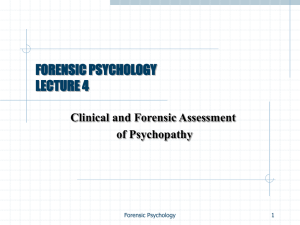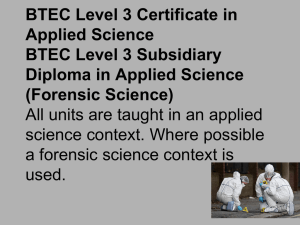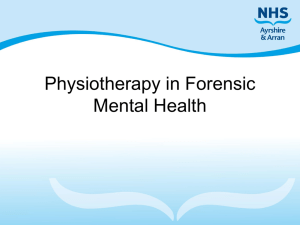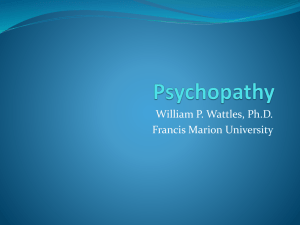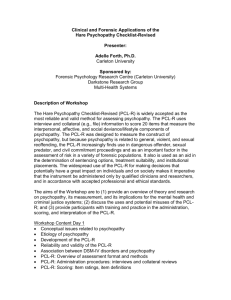Lecture 3: Clinical and Forensic Assessment of Psychopathy I
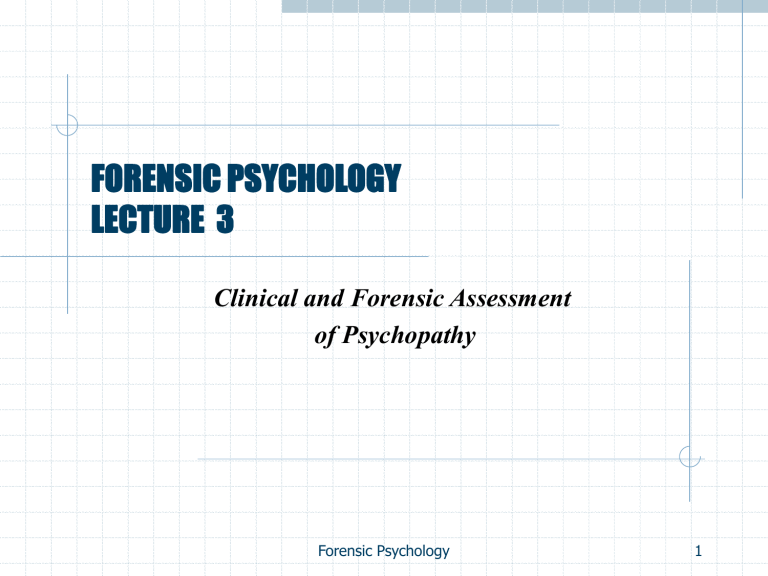
FORENSIC PSYCHOLOGY
LECTURE 3
Clinical and Forensic Assessment of Psychopathy
Forensic Psychology 1
Recommended Reading
Gacono, Carl B. (2000), The Clinical and Forensic Assessment of
Psychopathy Practitioners Guide.
London: Lawrence Erlbaum Associates .
(Chapters 3, 4, 6, 7, 8, 10, 13).
Howitt, Dennis), (2009) , Introduction to Forensic and Criminal Psychology:
3rd Edition.
London: Pearson Prentice Hall – Chapter 20.
Millon, Theodore; Simonsen, Erik; Birket-Smith, Morten; and Davis, Roger D.
(1998), Psychopathy: antisocial, criminal and violent behaviour.
New York:
Guilford .
(Reading: Chapters 1, 2, 4, 6, 9, 12, 10, 12, 27).
Articles:
Hare, Robert D. (1998).
The Hare PCL-R: Some issues concerning it's use and misuse . Legal and Criminal Psychology. 3, 99-119.
Herpertz, Sabine and Sass, Henning (1997).
Psychopathy and antisocial syndromes . Current Opinion in Psychiatry. 10, 436-440.
2
Forensic Psychology
Aims of Lecture
Examine the link between mental illness and crime
Describe what is meant by the term “psychopathy” and understand the difficulties associated with defining psychopathy
Describe the usefulness of the Hare Psychopathy Checklist –
Revised (PCL-R).
Examine the concept of assessing risk and recidivism in forensic populations.
3
Forensic Psychology
Mental Illness and Crime
Concept of Mental Illness is perceived in different ways between the professions of psychology and law. The media have an effect on the public perception of mental illness and crime.
Link et al (1992) –Sample of 500 never treated residents/mental patients in NYC. Psychiatric Epidemiology
Research Interview – assessing mental illness symptoms.
Although patients reported higher levels of violence, age, gender and education level were a higher predictor of violent behaviour than psychotic symptoms.
4
Forensic Psychology
Mental Illness and Crime
Swanson (1990) – US study using the Diagnostic Interview
Schedule. While schizophrenia was associated with violence, substance abuse was a greater predictor in the likelihood of violent behaviour.
Hodgins (1997) Stockholm – 15,000 born in 1953
MEN - 32% with no mental illness criminals/ 50% of mentally ill criminal
WOMEN - 6% with no mental illness criminals/ 19% of mentally ill criminal
Why?
5
Forensic Psychology
History of Psychopathy
“We cannot treat, except empirically, what we do not understand and we cannot prevent what we do not comprehend”
Brittain (1970)
Pinel (1800 ’s)
“Manie Sans Delire” – insanity without a confusion of mind.
Patients engaged in impulsive and self damaging acts, despite the fact that their reasoning was intact and that they knew what they were doing was irrational.
6
Forensic Psychology
History of Psychopathy
Cleckley (1976) – “The Mask of Sanity” – Proposed that psychopaths present a convincing mask with superficial charm, good intelligence, etc, yet are impulsive, have poor judgment and lack remorse.
16 characteristics including interpersonal, affective, cognitive and behavioural characteristics associated with an impulsive, irresponsible lifestyle.
7
Forensic Psychology
Cleckley’s Characteristics
Superficial Charm
Absence of Delusions
Absence of Nervousness
Unreliability
Lying
Lack of Remorse
Anti-social Behaviour
Poor Judgment
Egocentric
Poor Reactions
Lack of insight
Unresponsiveness in interpersonal relations
Alternative behaviour
Threat of Suicide
Promiscuous
Lack of Life Plan
Forensic Psychology
8
Terms
Antisocial Personality Disorder(ASPD)
Sociopathy
Psychopathy
(Terms used interchangeably in the literature)
Sociopathy diagnosis in DSM I
– sexual deviation, alcoholism and anti-social behaviour were features.
9
Forensic Psychology
Anti Social Personality Disorder
18 years
Conduct Disorder before age 15
Violations of law
Disregard for others/self
Deceitfulness
Impulsivity
Irritable/aggressive
Lack of Remorse
Forensic Psychology
10
Hare Psychopathy Checklist
PCL-R – 20 item 40 point scale completed with a semi-structured interview, and a review of independent and historical and contemporaneous data
PCL-SV – 12 item scale
Factor 1 – Interpersonal/affective features – callousness, lack of remorse.
Factor 2 – behavioural/affective features – socially deviant lifestyle.
11
Forensic Psychology
Hare Psychopathy Checklist
1.
Glibness/Superficial Charm
2.
Grandiose sense of self-worth
3.
Need for stimulation/proneness to boredom
4.
Pathological Lying
5.
Conning/Manipulative
Forensic Psychology
12
Hare Psychopathy Checklist
6.
Lack of remorse or Guilt
7.
Shallow Affect
8.
Callous/Lack of Empathy
9.
Parasitic Lifestyle
10.
Poor Behavioural Controls
Forensic Psychology
13
Hare Psychopathy Checklist
11.
Promiscuous Sexual Behaviour
12.
Early Behavioural Problems
13.
Lack of Realistic Long Term Goals
14.
Impulsivity
15.
Irresponsibility
Forensic Psychology
14
Hare Psychopathy Checklist
16.
Failure to accept Responsibility for Own Actions
17.
Many Short Term Marital Relationships
18.
Juvenile Delinquency
19.
Revocation of Conditional Release
20.
Criminal Versatility
Forensic Psychology
15
Anti Social Personality Disorder/Psychopathy
Behavioural Criteria in ASPD – behaviour that is observable and can be agreed on by clinicians, but
Does not inform us about character
Does not predict behaviour
Does not suggest any specific type of treatment
Most psychopaths will meet criteria for DSM ASPD but ASPD will not meet criteria for psychopathy
16
Forensic Psychology
Anti Social Personality Disorder/Psychopathy
Psychopathy – behavioural criteria and personality traits
APA (1994) – forensic population study:
80% met criteria for ASPD
15-25% met criteria for psychopath.
Quinsey, Rice & Harris follow-up study of offenders(1995):
Psychopath – 80% committed offences
Non-psychopath – 20% committed violent offences
Forensic Psychology
17
Administration of PCL-R
Historical information
Record review
Clinical Interview
Greater than or equal to 30 psychopath
Over 32.5
– likely to be violent .
Forensic Psychology
18

